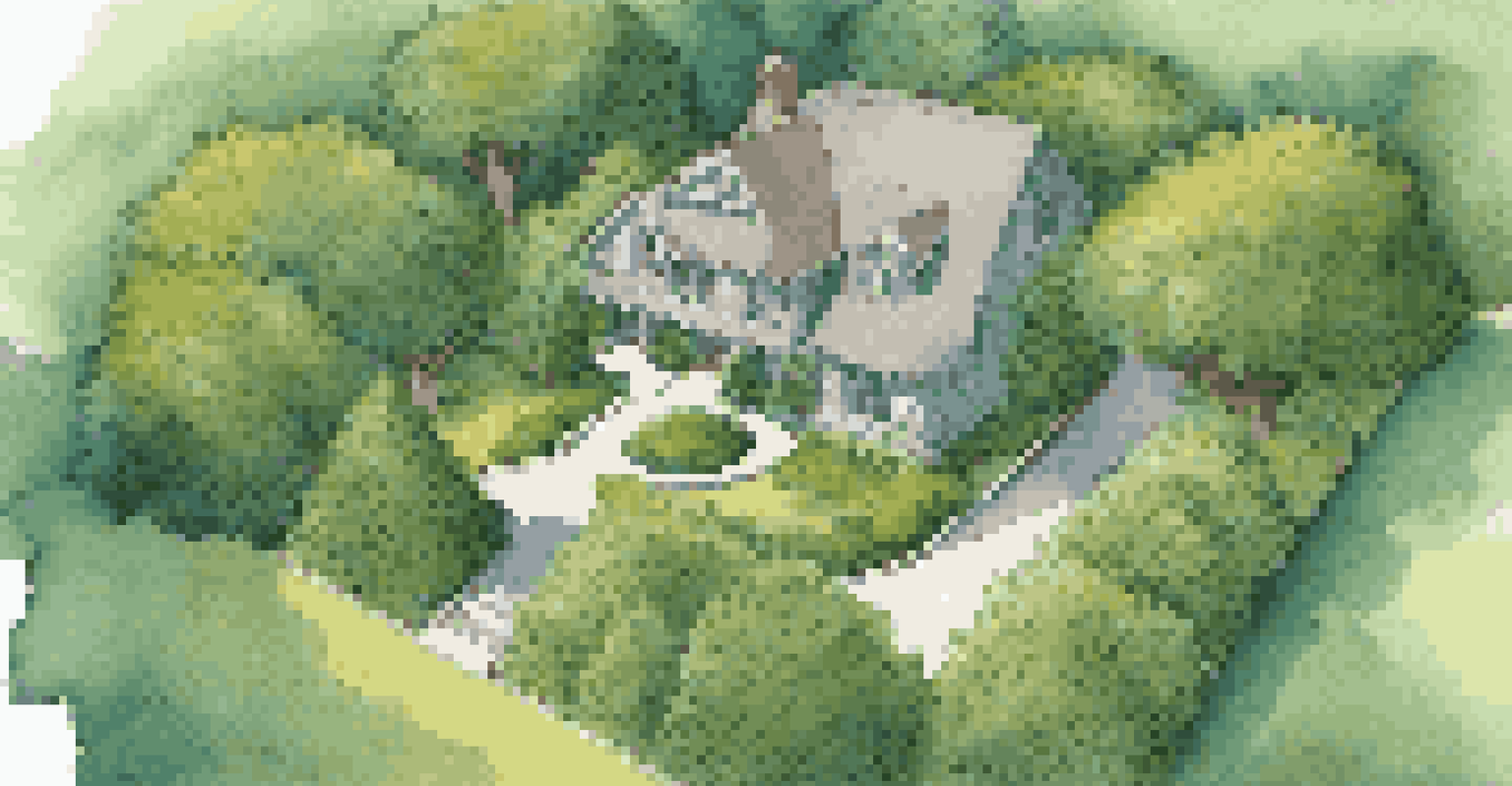Landscaping Strategies to Improve Your Home's Energy Efficiency

Understanding How Landscaping Affects Energy Use
Landscaping isn't just about aesthetics; it plays a crucial role in energy efficiency. By strategically placing trees, shrubs, and plants around your home, you can create natural barriers that reduce heating and cooling costs. For instance, a well-placed tree can provide shade during summer, lowering your air conditioning needs and cooling your home naturally.
The best time to plant a tree was twenty years ago. The second best time is now.
Moreover, landscaping helps to manage wind flow. Windbreaks made of trees or hedges can shield your house from chilly winds in the winter, thus maintaining warmth inside without relying heavily on heating systems. This simple intervention can lead to a noticeable drop in energy bills, making your home not only more comfortable but also more economical.
In essence, understanding the relationship between landscaping and energy use empowers homeowners to make informed decisions. By aligning nature's design with your home's architecture, you can enhance energy efficiency while also beautifying your surroundings.
Choosing the Right Plants for Energy Efficiency
When it comes to improving energy efficiency through landscaping, plant selection is key. Opt for native plants that are adapted to your climate, as they typically require less water and maintenance. Additionally, consider planting deciduous trees—those that lose their leaves in winter—on the south and west sides of your home to provide shade in summer while allowing sunlight in during winter.

Evergreens, on the other hand, can be positioned to act as windbreaks. Their dense foliage can shield your home from cold winds, particularly during harsh winters, helping to maintain a stable indoor temperature. Combining these two types of plants creates a balanced approach to energy efficiency throughout the year.
Landscaping Boosts Energy Efficiency
Strategically placed trees and plants can significantly reduce heating and cooling costs by creating natural barriers.
Ultimately, the right plant choices can lead to a more sustainable landscape that enhances your home’s energy profile. By aligning your plant selection with seasonal changes, you can create an environment that supports energy savings year-round.
Implementing Strategic Tree Placement
Strategic tree placement is one of the most effective landscaping strategies for energy efficiency. Placing trees on the east side of your home can provide early morning shade, reducing the need for air conditioning during those hot summer months. Meanwhile, trees on the west side can block the intense afternoon sun, offering additional cooling benefits.
Landscape is a piece of earth sculptured by human hands.
Furthermore, the height and type of trees matter significantly. Taller trees can create a substantial shadow effect, while low-growing shrubs can help with ground-level cooling. This layered approach not only provides aesthetic appeal but also maximizes energy savings.
Incorporating the right trees into your landscape can transform your home's energy dynamics. With careful planning and placement, you can enjoy a cooler home in the summer and reduced energy bills, making your outdoor space work for you.
Creating Shelterbelts for Wind Protection
A shelterbelt is a row of trees or shrubs planted to protect against wind, and it's an excellent strategy for enhancing energy efficiency. By creating a windbreak around your property, you can significantly reduce the wind chill factor during winter, leading to lower heating demands. This is particularly beneficial for homes located in open areas where winds can be harsh.
In addition, shelterbelts can help reduce energy costs by lessening the impact of wind on your home's exterior. By slowing down the wind speed, these barriers can minimize heat loss from your home, allowing your heating system to work more efficiently.
Choose Native Plants Wisely
Selecting native and seasonal plants enhances energy efficiency by requiring less maintenance and optimizing shade.
Incorporating a shelterbelt into your landscaping plan not only enhances your home's energy efficiency but also adds a layer of beauty to your outdoor space. Consider a mix of evergreens and deciduous trees to provide year-round protection while promoting biodiversity.
Utilizing Ground Cover Plants for Insulation
Ground cover plants are often overlooked, but they can play a significant role in energy efficiency. These low-growing plants create a natural blanket over the soil, helping to retain moisture and reduce the need for irrigation. Additionally, they can provide insulation for the soil, keeping it cooler in the summer and warmer in the winter.
By covering bare soil, ground cover plants also reduce the risk of erosion and improve soil health. This contributes to a more sustainable landscape that can help mitigate the impacts of climate change. Plus, they can add an appealing aesthetic to your yard, creating a lush, green appearance.
Incorporating ground cover plants not only enhances the beauty of your landscape but also supports energy efficiency. Their ability to regulate soil temperature can ultimately lead to reduced energy costs and a more comfortable home.
Incorporating Hardscape Elements Wisely
Hardscape elements such as patios, walkways, and retaining walls can also influence your home's energy efficiency. For instance, using materials that absorb heat, like dark-colored stones, can create microclimates around your home. This can be beneficial in cooler months but may require careful planning to avoid excessive heat in summer.
In contrast, lighter-colored materials can reflect sunlight, helping to keep your outdoor spaces cooler. Incorporating shade structures, like pergolas, can also provide relief from the sun, reducing the need for air conditioning indoors.
Sustainable Practices Matter
Implementing sustainable landscaping practices not only improves energy efficiency but also supports the local ecosystem.
By thoughtfully integrating hardscape elements into your landscape design, you can enhance both the functionality and energy efficiency of your home. This balance allows you to enjoy outdoor spaces while keeping energy costs in check.
The Role of Sustainable Practices in Landscaping
Implementing sustainable landscaping practices is crucial for maximizing energy efficiency. This includes using organic fertilizers, employing native plants, and minimizing water use through efficient irrigation systems. Not only do these practices support your local ecosystem, but they also contribute to lower energy consumption.
Moreover, sustainable landscaping often involves composting and mulching, which can enrich soil health and reduce the need for chemical fertilizers. Healthier soil supports strong plant growth, creating a more effective natural barrier against temperature extremes.

By committing to sustainable practices, you’re not just improving your home’s energy efficiency; you’re also making a positive impact on the environment. This holistic approach leads to a healthier planet and a more enjoyable living space.